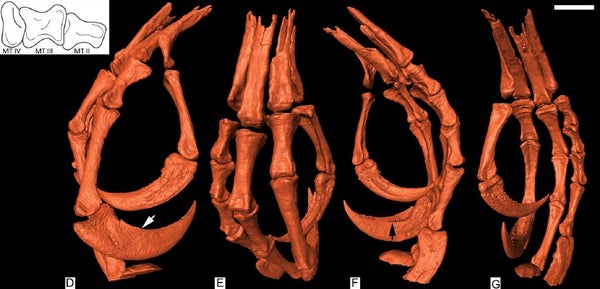This article was published in Scientific American’s former blog network and reflects the views of the author, not necessarily those of Scientific American
Paleontologists owe a debt to carnivores. I know this might sound a little counterintuitive. Scavengers are often cursed during discussions of taphonomy, agents of destruction that break apart and scatter bodies of organisms that may have otherwise entered the fossil record in a pristine state.
But this can’t be right. The standard unit of what enters the fossil record is not “body.” Consider the largest dinosaurs of all time. It would take pretty unusual, and even violent, sedimentology to bury an animal over 100 feet long and weighing more than 50 tons. And even at a smaller scale, sometimes the mode of preservation - be it by sand dune, ash fall, floodplain, or, as we’ll see, enclosure in amber - has certain size parameters that don’t work for whole bodies. So when a carnivore breaks apart a body, they may actually be doing us a favor. Whole bodies that might have entirely decayed were split into pieces that stood a better chance of preservation. That’s what probably happened to a fossil bird foot and wing fragment found in Burmese amber, proof that something is better than nothing.
Paleontologist Lida Xing and colleagues described the 99 million-year-old fossil earlier this year. It’s a gorgeous specimen, preserving not only bones but scales and feathers of an enantiornithine bird. For non-specialists, that’s a form of bird that thrived during the Age of Dinosaurs but went extinct at the close of the Cretaceous, making room for the ancestors of our modern birds to take off. And, as the researchers point out, specimens like these are a wonderful supplement to fossils found elsewhere. Fossils like this reveal detailed anatomy that can be flattened or otherwise obscured by other forms of preservation. Amber inclusions are as close as we’re going to get to time capsules sent to us from the Cretaceous world.
On supporting science journalism
If you're enjoying this article, consider supporting our award-winning journalism by subscribing. By purchasing a subscription you are helping to ensure the future of impactful stories about the discoveries and ideas shaping our world today.
It seems the bird the parts once belonged to was a juvenile. The fossil is an anatomical snapshot of a young enantiornithine. And the specimen helps fill in three-dimensional detail of what the plumage of these birds was like. For one thing, the foot is extensively feathered. That came as a surprise given that fossils formed by other means don’t often preserve plumage there. DIP-V-15105, as the fossil is known to experts, shows what we’ve been missing.
Naturally, finding pieces of a bird might make us bemoan the loss of the complete animal. “Where’s the rest of it?”, as the common fieldwork refrain goes. But if the bird had been left completely intact after death, perhaps it wouldn’t have been preserved. We’re lucky to have any such fossil at all, and we likely have a predator to thank.
So far as Xing and colleagues could discern, the foot had a bit of a rough time before becoming preserved. “The combined preservational features of the foot suggest that it was torn from the rest of the body prior to entering the resin,” the paleontologists write. Something likely munched a living or recently-dead bird, shearing off the foot and leaving it to get gummed up, dried out inside the resin, and ultimately fossilized.
It’s not impossible for more complete fossils to be preserved in amber. Some of the same researchers described a baby bird enclosed in resin in 2017. But there’s obviously some size limit to this kind of preservation. We’re not going to find a sauropod fully enclosed in orange glop. That means carnivores - and even environmental processes - that broke down larger bodies into preservable pieces were doing us a service. Just like you can’t make an omelette without breaking a few eggs, you can’t get a fossil record without breaking a few bones.
